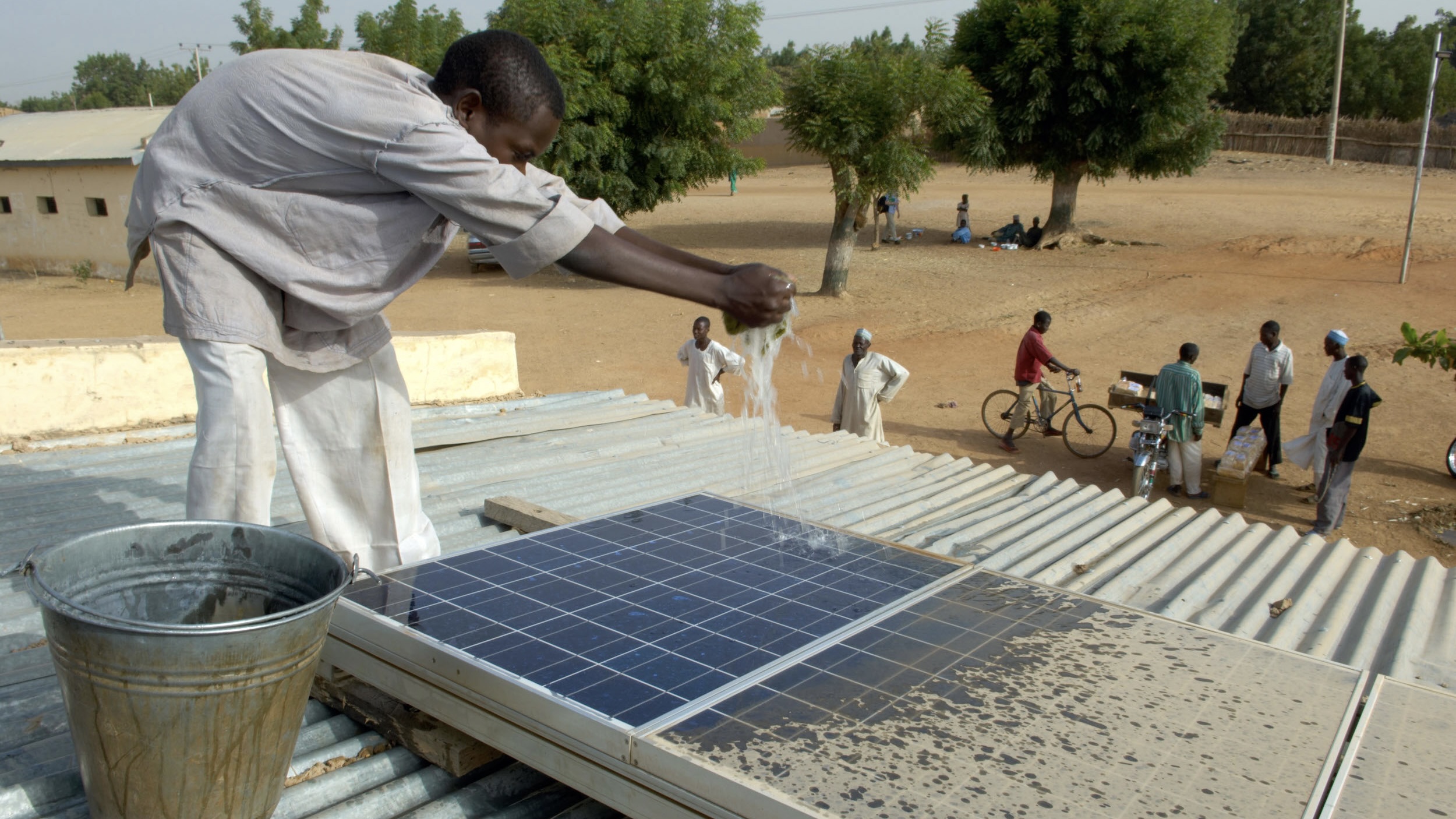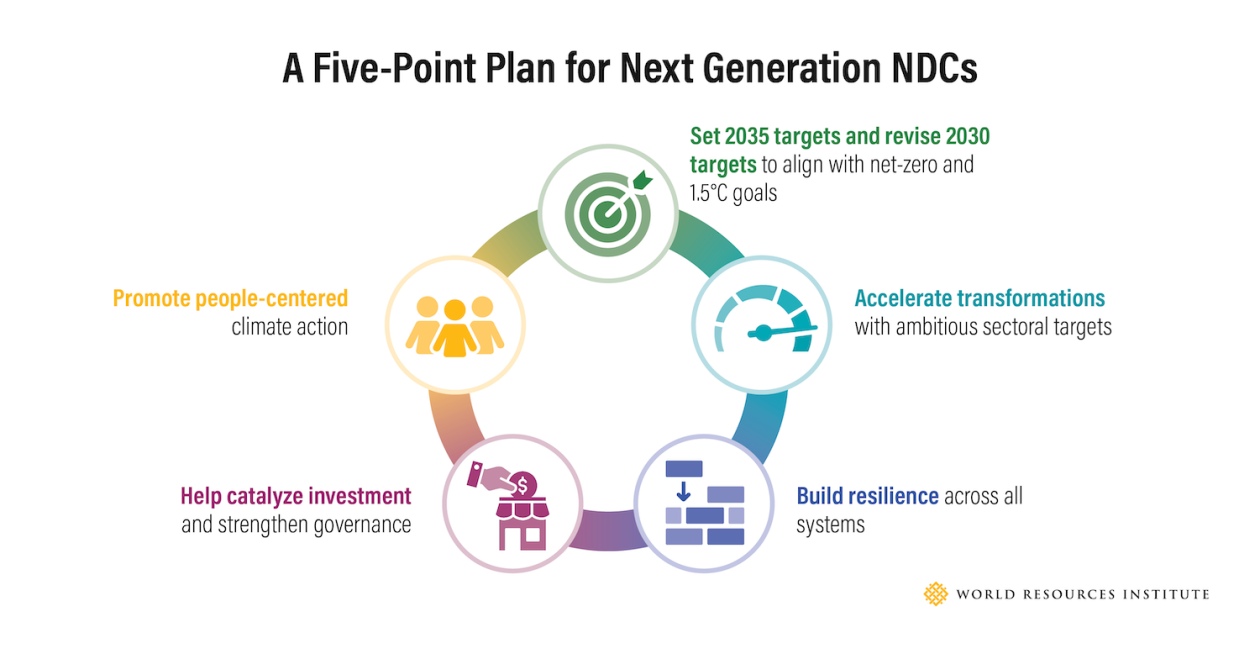
By early 2025, countries are due to unveil new national climate commitments under the Paris Agreement, known as nationally determined contributions (NDCs). These commitments form the foundation of international climate action, establishing emissions-reduction targets and other measures that countries promise to implement. The Paris Agreement requires nations to put forward new NDCs every five years, with each round stronger than the last. In short, NDCs are important because they are the main vehicle for countries to collectively confront the global climate crisis.
Yet NDCs to date fall well short of what’s needed to avert increasingly dangerous climate impacts and hold global temperature rise to 1.5 degrees C (2.7 degrees F). A recent UN report found current commitments put the world on track for a catastrophic 2.5-2.9 degrees C (4.5 – 5.2 degrees F) of warming by 2100.
Key developments since the last round of NDCs in 2020 can help spur countries to step things up considerably this time around. The question is: Will they rise to the occasion?
The Seeds for Stronger Climate Action Are Taking Root
Indeed, the impetus for ambitious national climate action has never been stronger. For instance, most countries now have targets to achieve net-zero emissions by or around 2050. This round of NDCs will extend to 2035 – the midpoint between 2020 (when many countries began implementing their NDCs) and 2050 – making them an important milestone for aligning near- and mid-term action with long-term aspirations. The new NDCs must also be informed by last year’s Global Stocktake, a UN assessment that reveals the shortcomings in current national climate policies and clearly calls for countries to move away from fossil fuels, as well as transform transportation, food and agriculture, and more.
Countries are also increasingly joining global cooperative initiatives on issues ranging from food and forests to renewable energy and methane; translating those commitments into NDCs could unlock stronger ambition. Finally, new scientific evidence like last year’s Intergovernmental Panel on Climate Change (IPCC) report reveals that the impacts of climate change are leading to more devastating consequences sooner than anticipated, reinforcing the urgent need to curb emissions, drive adaptation and significantly increase financing for both.
In the past, too many NDCs fell short of their potential to set out the ambition and actions needed for truly transformative climate action. This time around, NDCs must evolve to set the sights of government on the pace and scale of change needed and advance implementation to deliver it.
Here, we propose a five-point plan for the next generation of NDCs:

1) Set 2035 and strengthen 2030 emissions-reduction targets aligned with 1.5-degrees C and net-zero emissions goals.
Research shows that preventing increasingly dangerous impacts of climate change requires limiting global temperature rise to 1.5 degrees C above pre-industrial levels. That means cutting global greenhouse gas (GHG) emissions by 43% by 2030 and 60% by 2035, relative to 2019.
This is a collective goal supported by 194 vastly different countries, so it’s hard to prescribe a single, objective 2030 and 2035 emissions target at the national level (though various tools can help do so). Two things, however, are clear: First, countries, especially major emitters, must go much further in their emissions cuts than their current NDCs. And second, developed countries — historically the world’s largest emitters — have a responsibility to make the deepest reductions while providing substantially more finance to help developing countries accelerate climate action.
Less ambiguous than the collective 1.5-degrees C goal are the net-zero emissions targets that most countries have now adopted. Those countries should ensure that their 2030 and 2035 targets put them on a realistic path to phasing out emissions entirely by their net-zero target date. The window to align near- and mid-term climate action with long-term goals is finite. Infrastructure, for example, can take decades to turn over. If NDCs continue to lag so far behind, long-term goals will not be met without costly interventions later. The UN invited countries to submit their long-term climate strategies by November 2024, which can help inform countries’ near-term actions in their 2025 NDCs.
Finally, all countries should set targets that include non-CO2 GHGs such as methane. Reining in these potent climate pollutants is among the fastest ways to reduce near-term warming, yet some countries still do not address them in their NDCs. Last year, China made a significant commitment to include non-CO2 emissions for the first time in its new NDC. This is especially important, as China’s non-CO2 emissions alone would rank among the world’s top 10 national emitters of total GHGs.
2) Accelerate systemwide transformations by establishing ambitious, timebound sectoral targets.
Limiting global temperature rise to 1.5 degrees C will require immediate action to transform nearly every sector. To spur such far-reaching changes, countries should set sector-specific targets that underpin their topline emissions-reduction goals, as well as jumpstart a process with ministries to integrate these targets into their strategic planning. Doing so can help guide domestic policymaking across the whole of government, signal the direction of travel to public and private sector investors and enable more effective implementation.
While most NDCs currently commit to reducing economy-wide GHG emissions, fewer feature sector-specific goals. But establishing ambitious, timebound targets for the energy system (which includes energy supply and end use sectors like transport), as well as for food, agriculture and land, will be particularly important, as these sectors collectively emit about 90% of GHGs globally.
A just transition to zero-carbon energy.
NDCs should commit to phasing down fossil fuels rapidly this decade, while also scaling up zero-carbon power; electrifying buildings, industry and transport; shifting to low- and zero-carbon fuels in harder-to-abate industries like steel and cement; and improving energy efficiency.
Fortunately, countries aren’t starting from scratch. The Global Stocktake, as well as multilateral commitments like the Global Renewables and Energy Efficiency Pledge, provide building blocks for national target-setting. At COP28, for example, countries agreed to transition away from fossil fuels, triple renewable energy capacity by 2030 and advance efforts to achieve net-zero energy systems by mid-century. These political commitments represent significant progress. NDCs should reaffirm them.
But to limit warming to 1.5 degrees C, countries will also need to go further. One study, for example, finds that zero-carbon power sources like wind and solar must account for at least 88% of electricity generation by 2030, while coal and unabated fossil gas should decline to no more than 4% and 7% of power generation by the end of this decade, respectively. Similarly, decarbonizing transport will require bringing jobs, services and goods closer to where people live to avoid motorized travel; doubling public transit infrastructure across urban areas; and increasing the share of electric vehicles in the passenger car fleet to at least 20% this decade.
Countries do not need to progress at the same pace or reach the same target to achieve these global benchmarks. While developed countries have a responsibility to go furthest, fastest, other major emitters also need to decarbonize rapidly to keep the 1.5-degrees C limit within reach, though some may require finance and other support to do so. Still, these benchmarks provide a rough approximation of where nations need to be in the near term.
Finally, NDCs should lay the groundwork for a just and equitable energy transition by committing to extend affordable, reliable electricity access to those currently living without it, provide safe and accessible mobility for all, and support those negatively impacted by the shift to zero-carbon energy, such as fossil fuel workers.
A shift to resilient food systems that feed a growing population, help halt deforestation and reduce emissions.
Today’s farmers face an enormously difficult task of boosting agricultural productivity to improve food security in the face of intensifying climate change impacts, while also shifting to practices that enhance soil health, safeguard water and mitigate climate change. Agriculture, forestry and other land uses, for example, account for nearly one-fifth of annual GHG emissions globally; when combined with emissions across food supply chains, this share jumps to roughly a third.
Recent years have seen this sector rise up the political agenda, with an increasing number of countries referencing it in their current NDCs, the inclusion of ecosystem conservation within the Global Stocktake and the Global Goal on Adaptation’s target to attain climate-resilient food systems. Complementary commitments like the “Glasgow Leaders’ Declaration on Forests and Land Use” and the “Emirates Declaration on Sustainable Agriculture, Resilient Food Systems and Climate Action” have also received widespread support from countries.
Though these developments are welcome news, NDCs must go further to deliver the Paris Agreement’s goals, including to protect vulnerable farmers, particularly smallholders, from intensifying impacts and to lower food systems’ emissions.
On the demand-side, all countries should set targets to halve food loss and waste by 2030, while those in high-consuming regions (the Americas, Europe and Oceania) should aim to lower per capita consumption of emissions-intensive beef, lamb and goat to two servings per week or less by the end of this decade. Supply-side, 1.5-degrees C benchmarks call for reducing global GHG emissions from agricultural production by 22% this decade, while also sustainably boosting crop yields by 18% and building resilience. Pairing these food and agriculture goals with those focused on halting and reversing ecosystem loss, particularly for forests, peatlands, mangroves and grasslands, is also urgently needed to help conserve the world’s carbon sinks and stores.
Critically, efforts to achieve these targets must be pursued in tandem. Failure to do so risks unintended consequences, such as farms expanding into forests and accelerating biodiversity losses, tree-planting across productive croplands that harms farmers’ livelihoods and threatens food security, or adoption of agricultural practices that increase yields but heighten vulnerability to climate change by degrading soil or overdrawing groundwater.

3) Build resilience to increasingly dangerous and irreversible impacts.
With escalating climate impacts like heatwaves, severe storms and wildfires, as well as longer-term, slow onset effects like sea level rise and desertification, it’s increasingly crucial for countries to step up their efforts to adapt and build resilience. Despite their focus on mitigation, NDCs — along with other tools like national adaptation plans — play a vital role in elevating the political profile of adaptation and facilitating much-needed shifts in policies and finance.
This next generation of NDCs follows adoption of the first Global Goal on Adaptation, which outlines sectoral adaptation targets. Countries can refer to these global priorities when identifying national and local priorities, such as attaining climate-resilient food and agricultural production and distribution; building resilience to climate change-related health impacts; and reducing climate impacts on ecosystems and biodiversity, among others. This requires conducting periodic vulnerability assessments, undertaking cost-benefit analyses (using the “triple dividend” approach), and consulting mayors and local communities to prioritize opportunities for enhancing adaptation and strengthening actions to keep pace with intensifying climate impacts. Once implementation begins, progress should be tracked through the development of monitoring, evaluation and learning systems.
The NDC process also offers countries the opportunity to engage the most vulnerable communities and Indigenous Peoples in developing national adaptation measures. Inclusive stakeholder participation helps ensure that investments in adaptation and climate-resilient development meet local needs. The principles for locally led adaptation can help guide implementation.
Finally, NDCs offer countries a chance to prioritize loss and damage, and thereby raise awareness of areas in which the limits to adaptation are likely to be exceeded. This can include providing specific information on financial costs and technical and capacity needs to respond to the most severe impacts of climate change, as well as national efforts related to disaster-risk reduction, humanitarian assistance, rehabilitation, migration and slow-onset events, such as loss of biodiversity and erosion of cultural heritage.
4) Spur investment and strengthen governance to turn targets into practice.
It is critical that NDCs not only make commitments, but also lay the groundwork for implementing them. This includes a vision for how government ministries, subnational governments, the private sector and civil society, as well as others, will work together to turn ambition into reality, including through policies, institutions and finance.
To start with, implementing NDCs will require a whole-of-government effort. The profile, legitimacy and associated international scrutiny of the NDC process can shift the political calculus, creating opportunities to strengthen climate governance accordingly. For example, as they develop their NDCs, countries can pass laws or foster coordination across the entire government — from the head of state and all-important economic ministries to line ministries and regulatory bodies. The process can also help facilitate consensus-building and integrate climate issues into mainstream planning, policy, finance and legislative decisions. The NDC document itself can describe allocation of responsibility for implementation to certain ministries, and note whether the country is establishing or strengthening national climate bodies that can drive forward integration and accountability. Leveraging these opportunities may prove critical to establishing the legal and institutional infrastructure necessary to implement ambitious goals.
The NDC process is also an opportunity to engage subnational actors such as cities, states, regions and local communities. This can achieve several goals: ensuring alignment between local and national climate goals; strengthening subnational implementation via policies and budgets; and increasing countries’ overall ambition.
Implementation of NDCs will also depend on investment and finance. Ambitious targets and policy objectives in a country’s NDC can send strong signals to investors and finance providers that the government is committed to the climate agenda. This signal is even stronger if NDC targets, policies and institutional measures are integrated into core national and sectoral plans. This can help to mobilize the finance and investment to carry out national commitments.
But the NDCs’ targets and measures, even if strengthened through integration into core national and sectoral planning, cannot stand alone if they are to succeed. They’ll need to be buttressed by credible strategies to mobilize investment and financing. Such strategies would build on but go beyond the estimates some developing countries made in previous NDCs of the cost of their proposed actions. They can also delineate the actions countries could finance domestically and those which would be conditional on international finance.
Strategies can also identify a pipeline of bankable projects. Clear finance strategies will not only strengthen the viability and credibility of countries’ NDC targets, but also help turn commitments into action.
NDC investment strategies can also provide a rallying point that enables developing country governments to bring together public financing partners (e.g. multilateral development banks, development finance institutions, climate funds, donors, philanthropists) and the private sector to coordinate how they will support countries’ targets. Such coordination processes — which should be driven by a country’s own objectives and internal alignment could enable the co-creation of project pipelines, structure investment programs and help identify policies that encourage greater investment.
5) Put people at the center, ensuring climate action creates jobs, improves health and more.
Given the widespread ramifications of climate change and the many potential benefits of tackling it, NDCs will need to draw clear linkages to a wide range of issues that are critical for peoples’ lives – from employment to health to local economies and beyond. Doing so is essential to maximize the economic, development and social opportunities from well-planned climate policies, as well as for managing challenges like loss of livelihoods for workers in the fossil fuel industry or certain types of land use. Taking these issues into account is also critical for building public and political support for greater climate action.
Some NDCs have already highlighted connections between the actions they lay out and the Sustainable Development Goals, while others refer to “just transitions,” decent work and gender rights. Yet most current NDCs only skim the surface on these issues.
While NDCs cannot provide fully granular policies across all issues, what they can do is outline clear plans for a just transition, including working directly with communities, workers and other affected groups to develop strategies for an inclusive zero-carbon and resilient transition.
NDCs can also outline ways in which countries will support communities that might be negatively affected by zero-carbon, resilient development. These approaches could include employment creation and worker retraining, support for community development and economic diversification, social safety nets and more. NDCs can also provide quantitative goals on objectives such as access to high-quality green jobs, health improvements through pollutant reduction, and equitable access to renewable energy and sustainable transport.
What’s Next?
By 2035, the world needs to be on a radically different pathway if we have any hope of overcoming the climate crisis. The NDCs that countries submit by next year will show in black and white which countries are committed to slash emissions and accelerate adaptation quickly enough to get there.
Our five-point plan offers a blueprint for success: setting ambitious emissions-reduction targets aligned with the 1.5-degrees C limit, accelerating sectoral transformations, building resilience across all systems, catalyzing multi-stakeholder action and investment, and putting people at the center of climate action. By embracing these principles as they craft next-generation NDCs, countries can not only help avoid the devastating impacts of climate change, but also unlock opportunities for sustainable development, job creation and better public health.
This article originally appeared on WRI’s Insights.
Jamal Srouji is an Associate for WRI’s Global Climate Program.
Taryn Fransen is Director of Science, Research and Data for WRI’s Global Climate Program.
Sophie Boehm is Senior Research Associate for WRI’s Climate Program and Systems Change Lab.
David Waskow is Director of WRI’s International Climate Initiative.
Rebecca Carter is Director of Climate Adaptation and Resilience for WRI’s Global and U.S. Climate Programs.
Gaia Larsen is Director of Climate Finance Access for WRI’s Sustainable Finance Center.





